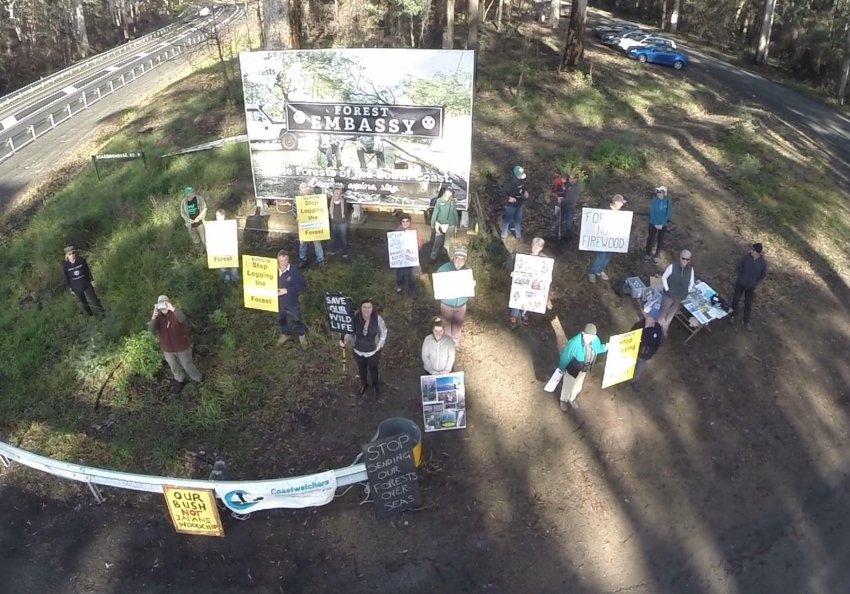
A “Forest Embassy” protest by Brooman State Forest Conservation Group on June 29 in the Shoalhaven area was organised to stop the logging of native forest that had survived the Black Summer fires and to highlight illegal logging of trees with hollows. It was supported by the Coastwatchers Association, the Milton branch of the National Parks Association and Friends of the Forest (Mogo).
A recent community inspection of Compartment 58A in South Brooman State Forest showed that NSW native forestry industry contractors had not complied with NSW Environment Protection Authority’s (EPA) post-fire logging requirements. The area next to the unburnt areas being logged is critical refuge to surviving endangered wildlife that sheltered from the fires along the creek area and is clearly marked out in green on recently issued logging maps.
Despite this, logging of the catchment on both sides of this unburnt river corridor started in May. The harvest plan map available at the NSW forestry portal shows how the loggers are working in areas surrounded on three sides by sloping creek lines that run into Bridge Creek, unburnt forest and wildlife protected areas.
Locals were shocked to find numerous protected trees with wildlife hollows cut down, particularly red mahogany trees. Following the community inspection, up to 20 illegal logging reports were filed with the EPA on June 21.
The next day, the EPA advised it would investigate. As the wood taken from these trees with hollows have been illegally harvested, it is clear that logging in native forests must immediately stop. The EPA is also investigating logging on 24 to 26 degree slopes, despite the EPA prohibiting logging on slopes over 20 degrees.
Large trees with hollows are crucial dwelling and breeding habitat for threatened forest species, including greater gliders, yellow bellied gliders and large forest birds such as powerful owls and glossy black cockatoos.
The NSW government BioNet holds records in this compartment for critically endangered swift parrots, a spotted tailed quoll, powerful owls and squirrel gliders. The spotted gum forests provide nectar to critically endangered swift parrots that migrate annually from Tasmania in winter to feed in the New South Wales south-east forests.
As Australia already has the worst record in the world for native wildlife species extinctions, keeping trees with hollows will be the difference between these species surviving or becoming extinct. Biologists have also estimated that up to 1 billion native animals perished in the summer fires in the forests of the Great Dividing Range.
Following the protest, activists discussed how to record the threatened species to trigger logging exclusion zones. This citizen science includes photographing endangered wildlife, spotlighting surveys using powerful red light torches (so as not to blind nocturnal native animals), surveys for birds’ nests, wombat burrows, as well as Australia's second largest native predator, the spotted tailed quoll. Records with photos and geospatial coordinates are then loaded to the NSW Environment department’s online BioNet.
Residents living next to the forests were advised they can demand a wide logging exclusion buffer zone beyond their property boundary. As we were discussing these plans, logging could be heard below the ridge, along with lyrebirds mimicking other birds in nearby creeks.
Despite forest industry claims that logging provides Australia’s “sustainable timber”, most of the trees are cut down for woodchips and firewood. Logging yield figures of this predominantly spotted gum forest with blackbutt, ironbark, stringybark and peppermint trees confirm this. Three quarters of the expected yield is for low-quality pulpwood (31%), firewood (16%) and salvage sawlogs (28%). Of the remaining high-quality yield, 9% are small sawlogs and only 16% large sawlogs.
Locals are also concerned about the increased fuel load from logging debris (up to 450 tonnes per hectare from entire treetops are being left on the ground — up to 65% of the tree) and driving risk and dirt road damage from logging trucks.
The fuel load is also increased from the exposed ground drying the forest out and thick stands of saplings replacing established forest with wide spaces dominated by single large trees. The environmental concerns of surviving wildlife, increased fuel load and traffic risk to local communities shows why the forestry industry must immediately convert to 100% plantation forestry. Plantation trees are efficient to grow, transport and process into wood and fibre, as shown by the plantation industry hub at Tumut.